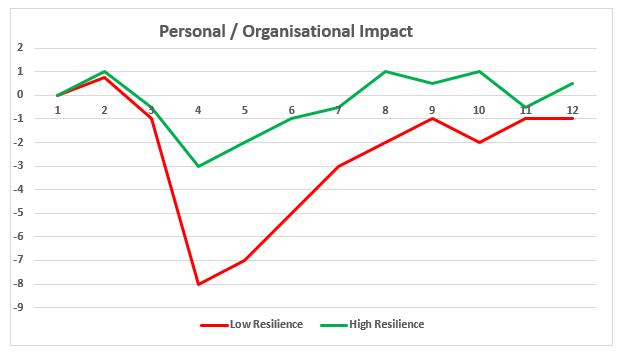The world around us seems to be changing at an incredible pace and regrettably, the change seen in the first three months of 2020 has not been good. The bush fires in Australia wreaked havoc whilst Covid-19 is changing the lives of the global population. If ever there was a time for resilience it is now.
Put simply, resilience is the ability to recover from difficulties quickly – the challenge is to minimise both the impact and the time frame. To demonstrate this, take a look at the graph below. It depicts the lives of two people, called Person Green and Person Red. The x axis represents an imaginary time line – this could be minutes, hours, days, weeks or maybe even years. The y axis represents an impact and, for the majority of the time this impact is negative.

At point 2 on the time line something happens, it doesn’t matter what but it is something that has caused a negative impact. Person Red does not have great resilience skills so the impact is significant and the time frame for recovery is long whereas Person Green does show resilience – the impact is less and the temporal component shorter.
Before looking at the process of resilience there are a couple of important notes to make.
Firstly, resilience does not equal robustness. The robust person is the person who constantly says ‘yes I’ll do it, not a problem, just leave it there and I can sort’. Their workload (or ‘lifeload’) keeps rising and rising. If you are like this, or you know someone who is like this, and you start to see chinks in the armour please do something, as when the robust person breaks, they often break big with the consequence either being damaged health, poor performance or both. With the increasing incidence of burnout that is being seen around the world (The Japanese even have a word, Karoshi, to define death through overwork) it would seem that either the number of robust people is increasing or our ability to spot and support the robust person is diminishing or, and I suspect this is most likely, it could be a combination of the two.
Secondly, resilience is not just about the world changing around us, it is also about how we adapt in our world. The following story makes the point well, it features my children, who at the ages of 23 and 20 have now mastered the skill of drinking a glass of water. However, when they were much younger, as a family, we would sit down for a meal in the evening and one of them was likely to spill their glass of water. Now, typically, I would go and get a cloth, wipe up the mess, refill the glass and sit down and enjoy a family meal. Occasionally however, at the same time, in the same location, with the same people, the same thing would happen – the trouble was my reaction would be totally different. The only thing that has changed in this exchange is me. We should remember that resilience is a two-way street and if we are honest, the easiest side of the street to control is our side. Resilience really does start with us.
Too many people and indeed businesses think that resilience just happens. It does not and whilst some may find dealing with the demands of day to day life easier than others, resilience is a skill and if this is broken down, then it is a skill that can be practised by all.
